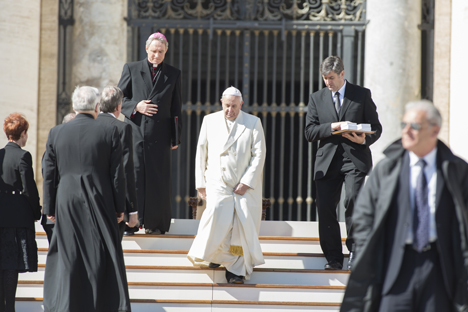Ever since 29 December and the publication of a pastoral letter by Poland’s Roman Catholic bishops condemning what they consider to be the deleterious consequences of “gender ideology” and “genderism”, news media and online fora in Poland have been abuzz with both denunciations and defences of the bishops’ statement. Many wise words have already been spoken on this question, of which I personally find most compelling the statements by Zbigniew Nosowski, editor-in-chief of Poland’s august Catholic quarterly Wiez (Bond), and the Rev. Alfred Wierzbicki, an ethics professor at the Catholic University of Lublin. Nonetheless, as a historian of the Catholic Church, I feel an obligation to provide some context that has been sorely missing from the ongoing debates.
The bishops’ letter: Theology or ideology?
The whole affair of the bishops’ letter underscores in stark terms the growing dissonance between Pope Francis and many (though not all) of Poland’s sitting bishops. Bishops have not only the right, but the pastoral duty to weigh in on cultural and social developments that may impact the lives, norms and values of the faithful. After all, there is nothing new about the Catholic hierarchy speaking out on matters of family and gender from the standpoint of biology, social anthropology or the sanctity of marriage under canon law.
And yet, in the case of the 29 December pastoral letter, both the manner in which it reached the public and the language used by the bishops set the stage for a scandal. Two dramatically different versions of the letter – one muted in its criticism of feminism and the LGBT community, the other uncompromising in its condemnations – were released to the public in advance of the letter’s official promulgation, stacking the deck in advance against a good-faith debate by polarizing the media and the faithful alike. Hence an immediate torrent of often vicious attacks by defenders of the letter against its critics. The publication of two alternate versions of the letter, as well as the freedom left by the Episcopate to individual bishops to choose whether or not to require that the letter be read aloud in their dioceses during Sunday mass, set the stage for a public reception of the document that was as differential – depending on which version, if any, a given person heard or read – as it was emotional.
In the letter, the Polish bishops chose to reference neither Genesis nor the Gospels, nor any papal encyclicals, invoking only two brief quotations, with no reflection as to their original context. One came from Gaudium et Spes, the pastoral constitution handed down at the end of the Second Vatican Council in 1965, the other from a speech delivered by John Paul II in 1980. The choice not to invoke in the letter the wealth of biblical or canonical sources attesting to a long history of ecclesiastical commentary on family, women and gender resulted in a document that is as shallow as it is reductive, containing no attempt at scholarly or exegetic analysis. Furthermore, the letter does not reference a single source by way of example of what it condemns as gender “ideology” or “genderism”. Please do not misunderstand me. I am not making a pedantic criticism of the letter for its lack of footnotes. Rather, what troubles me is the set of sweeping generalizations about “gender” in the letter that mask the absence of any serious, substantive treatment of arguments made by the other side.
The phrases “gender ideology” and “genderism” alone mark the letter as ideological, not dialogical. No surprise, then, that the entire Polish-language Internet is now rife with this ideologically charged language. Any number of authors use the Anglicism “gender” in their Polish-language writings as a catch-all slogan – radix malorum – with no appreciation for the word’s etymology or context in English-language social or scholarly debates. “Gender”, then, is neither merely “gender studies,” nor biology, nor ideology. The lack of sensitivity to context by Polish-language authors throwing around the English word with abandon has not only made it seem a dirty word, but indeed has bred a whole new canon of insults in Polish public discourse. For example, the Rev. Prof. Wierzbicki – who, it is worth noting, is Director of the John Paul II Institute of the John Paul II Catholic University of Lublin – expressed mild criticism of the bishops’ letter in an interview and was rewarded online with the rather unoriginal epithet of “the Reverend Genderist”. On the same prominent commentary site that christened the Rev. Wierzbicki thus, one can find another essay with the extraordinary title “Genderism is like Communism: And we must prepare ourselves for a long war!”
Such ad hoc totalizations, lacking both in a desire to understand the other side and a willingness to engage the substance of its specific arguments, can only breed divisions, cause harm, and counteract the “integral vision of the human being” that the bishops declared to be the putative goal of their letter.
And the history?
What exactly did the bishops have in mind when writing the letter? Was their goal to defend the institution of marriage? To strike a blow against feminism – and, if so, then what kind of feminism? To underscore their disdain for the LGBT community? Or rather to condemn all forms of scholarly inquiry into – as the Rev. Prof. Wierzbicki put it – “the experience of femininity and masculinity”? The bishops’ position, as articulated in the letter, renders impossible unequivocal answers to these questions. Thankfully, as in many such cases, history is an indispensable guide. I therefore offer a few historical examples from the past century of Catholic engagement with family, women and sexuality – precisely what is missing from the letter – in an attempt to contextualize what the Polish bishops were trying to achieve.
Over the course of the twentieth century, the Catholic Church has, on many occasions, handed down teachings on a range of social issues intended to inculcate in the faithful certain norms and values to be passed on to future generations. Pius XI’s 1930 encyclical Casti Connubii formalized in one coherent document the Church’s stance on family and marriage, drawing on the Gospels and the writings of St. Augustine, among others. The encyclical presented the sacrament of marriage as the key to securing and protecting the “dignity” of the “human person” in social life. Pius XI was convinced that the Catholic Church, confronted by free-market liberalism on the one hand and “bolshevistic and atheistic Communism” on the other, must adopt an uncompromising stance. The point was not merely to protect Catholic values from Communist infiltration, but to achieve maximum efficacy in spreading among Catholic youth both the core tenets of the faith and an unwavering conviction that every layperson must engage in public life. These aims were articulated even more clearly in Pius XI’s 1937 encyclical Divini Redemptoris, which portrayed Communism as intent on “upsetting the social order and undermining the very foundations of Christian civilization”.
Reading these words from 1937, one might be tempted to conclude that the Polish author declaring war in 2013 on “genderism” by way of a comparison with Communism has ample historical grounds for doing so. Nonetheless, unlike Communists – by and large identifiable by virtue of their membership in Communist Parties – one could easily classify as “genderists” any number of clergy or laity who have either drawn attention to or actively promoted women’s rights – including, among others, Pope Pius XI.
What’s more, Pius XI’s program of creating a strong, self-aware Catholic society in no way presupposed blanket rejections or blind declarations of war against all new ways of thinking. For example, the Marian Student Sodalities (Sodalicje Marianskie Akademików) – which in the course of their activity in Poland in the years from 1916 to 1949 came to call themselves “schools of apostles” – recognized the traditional model of the family as a “cell of the social and national organism”, yet they permitted no activities whatsoever that were not rooted in “working on oneself”. In fact, a pious Catholic was supposed to take full advantage of all available “contemporary methods of teamwork aimed at self-education and self-enlightenment” – in the words of the late Hanna Przeciszewska, a prominent activist of the Marian Sodalities and, later, of Warsaw’s Catholic Intelligentsia Club.
Not only is the bishops’ letter missing an exhortation for Catholics to “self-educate” on topics connected to gender but, above all, it lacks a definition of what exactly Catholics are to avoid – beyond the idea that “biological gender has no social meaning”, and that therefore “a person can choose to define himself as he wishes: whether he is a man or a woman; and he can also choose his own sexual orientation.” If one agrees that there is a basis for lambasting the Rev. Wierzbicki as a “genderist” then, by the same token, one should also criticize John Paul II, who in his 1995 “Letter to Women” spoke of “history which has conditioned us to a remarkable extent. In every time and place, this conditioning has been an obstacle to the progress of women. Women’s dignity has often been unacknowledged and their prerogatives misrepresented; they have often been relegated to the margins of society and even reduced to servitude.”
The fact that the Polish pope consistently and publicly stated his opposition to abortion and contraception, justifying those positions in terms of the rights of the human person to life and dignity, in no way justifies discrimination against women or LGBT communities. After all, successive popes throughout the second half of the twentieth century participated in the creation and development of an international culture of respect for human rights, which encompasses also differences of gender and sexual orientation.
What about the 2013 Person of the Year?
How should we think about all of this in light of statements by the 2013 Advocate and TIME Person of the Year, Pope Francis – widely viewed (especially by non-Catholics) as an icon of tolerance and openness within the Catholic Church? We have, on the one hand, the pope’s statement made on his way back from World Youth Day in Rio de Janeiro in July 2013, in response to a question about homosexuality among clergy: “If someone is gay and seeks the Lord with good will, who am I to judge?” In the course of the very same interview, however, Pope Francis demurred with respect to press reports regarding the existence of a “gay lobby” at the Vatican. He also addressed the role of women in the Church – categorically rejecting the idea of female priests, while also underscoring that women ought to be entrusted with tasks of the highest responsibility in Church administration and pastoral work.
Can Pope Francis’s words about “lobbies” within the Vatican be invoked to reinforce an attack on “gender ideology” – whatever that might be? Despite the long-standing involvement of the Holy See in defence of human rights, it is not difficult to find statements by Vatican officials recalling some of the phrasing of the Polish bishops’ letter of 29 December 2013. For example: the “theory of the human person intended to promote prospects for equality of women through liberation from biological determinism has in reality inspired ideologies which, for example, call into question the family, in its natural two-parent structure of mother and father, and make homosexuality and heterosexuality virtually equivalent, in a new model of polymorphous sexuality.”
The author of these words from a 31 May 2004 Vatican letter to the bishops of the entire Catholic Church was none other than Joseph Cardinal Ratzinger, the future Pope Benedict XVI. Moreover, the letter was approved by John Paul II himself. It is possible that this letter, now nearly a decade old, served the Polish bishops as a model for their own recent epistle. The principal differences between the letters lie in the quality and precision of the argumentation. The future pope offered an erudite, elegant argument referencing numerous passages from the Bible, various papal encyclicals, and other sources as well. Can one, then, consider his letter to have been an “anti-gender” document, in keeping with the understanding of that term promoted by the defenders of the recent Polish bishops’ letter? In effect, Ratzinger’s letter, though not free of harsh words, pursued a clearly and concisely defined goal: “Without prejudice to the advancement of women’s rights in society and the family, these observations seek to correct the perspective which views men as enemies to be overcome.”
If, then, the Polish bishops modelled their letter after the 2004 document, they have shown themselves to be anything but faithful to the original. It is unreasonable to ask that the Church declare to be in keeping with natural law everything that is said, written, and taught in courses in anthropology, cultural studies or more specialized interdisciplinary fields such as women’s studies, LGBT/queer studies or gender studies. Nonetheless, when the matter in question involves a mass communiqué broadcast in the middle of the Christmas holidays, one ought to expect not only an unequivocal, precise definition of what is at stake, but also an appropriate degree of contextualization – historical and otherwise. This is especially crucial in cases where imprecision and decontextualization can lead to acts of intolerance, not to mention declarations of “war” against entire social communities. In the case of the December letter, it is therefore difficult not to reach the conclusion – as have many of the letter’s critics – that the bishops’ principal goal was not pastoral, but PR-related: to distract from successive sex-abuse scandals within the Church.
Pope Francis insisted in a September interview with Civiltà Cattolica: “We must always consider the person. Here we enter into the mystery of the human being. In life, God accompanies persons, and we must accompany them, starting from their situation. It is necessary to accompany them with mercy.” On 29 December 2013, the very same Feast Day of the Holy Family on which the Polish Episcopate condemned “genderism”, Pope Francis in the Angelus prayer called for aid to “victims of human trafficking and of slave labour,” insisting that the lesson of the day should be “love and reconciliation, in which tenderness, mutual help and mutual forgiveness is experienced.” Clearly, there is a dissonance between the words coming from the Vatican and those coming from the Polish bishops. Why the singular path chosen by the Polish Episcopate? Should bishops not be emulating the pope in his chosen method of evangelization and social teaching?







